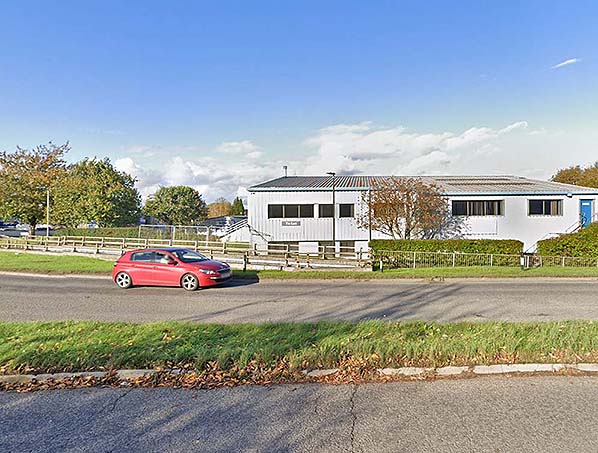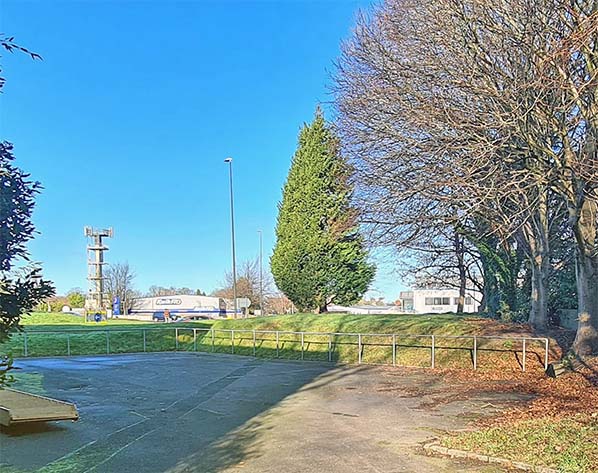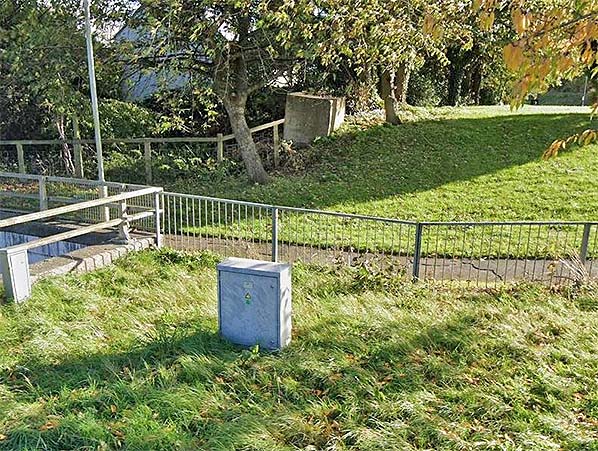
Station Name:CIRENCESTER WATERMOORwatermoor15.jpg) The stationmaster's house on the up platform. The building was later used as offices.
Photo by Dave Bushell from M&SWJR Odds and Ends web site watermoor17.jpg)
The M&SWJR locomotive works c late 1960s.The works closed after the Grouping in 1925 and the site had been a rail connected scrap yard for many years. When the goods yard finally closed in 1964, scrap was the only traffic.
Photo
by Dave Bushell from M&SWJR Odds and Ends web site
watermoor18.jpg)
The body makers and paint shop, part of the M&SWJR works, seen in late 1960s.
Photo by Dave Bushell from M&SWJR Odds and Ends web site watermoor19.jpg)
The end of the machine shop which was built as an extension to the works in 1915.
Photo by Dave Bushell from M&SWJR Odds and Ends web site watermoor20.jpg)
The body makers and paint shop. part of the M&SWJR works seen in late 1960s.
Photo by Dave Bushell from M&SWJR Odds and Ends web site watermoor9.jpg) Looking south along the Up platform at Cirencester Town station c1973, the derelict gas works is seen in the background. Within a few years everything would be cleared away during the construction of the new A429 road; again the top of the approach road is seen on the right. Looking south along the Up platform at Cirencester Town station c1973, the derelict gas works is seen in the background. Within a few years everything would be cleared away during the construction of the new A429 road; again the top of the approach road is seen on the right.Photo from John Mann collection watermoor7.jpg) Looking south from the station forecourt c1973. This is where the main station building stood. The truncated gasworks chimney is to the left of the JCB. Looking south from the station forecourt c1973. This is where the main station building stood. The truncated gasworks chimney is to the left of the JCB.Photo from John Mann collection watermoor8.jpg)
The photographer is standing midway along the Down platform of Cirencester Watermoor station, facing north. The tree lined approach road is seen with a lorry parked on it. The WWII anti-tank blocks seen in many photos at the rear of the Down platform are seen on the right. The small building with a sloping roof (probably a toilet for the scrap yard workers) is also seen in the picture above to the left of the JCB.
Photo from John Mann collection watermoor6.jpg) In this view of Cirencester Watermoor station c1973 the photographer was standing just beyond the south end of the platforms, looking north; the small hut and the JCB, both visible in other pictures are seen in the background. More WWII anti-tank blocks are seen on the right.
Photo from John Mann collection watermoor11.jpg) Looking south from the end of the Cirencester Watermoor platforms in August 1988. The embankment is the alignment and is still there today. This is the same place as the 2021 picture below but looking in the opposite direction. Looking south from the end of the Cirencester Watermoor platforms in August 1988. The embankment is the alignment and is still there today. This is the same place as the 2021 picture below but looking in the opposite direction.Photo by John Mann  Looking north across Bristol Road at the site of Cirencester Watermoor station. The platforms began on the south side of Bristol Road (behind the photographer) and continued across the road and though the west side of the Capita Education Services building. Looking north across Bristol Road at the site of Cirencester Watermoor station. The platforms began on the south side of Bristol Road (behind the photographer) and continued across the road and though the west side of the Capita Education Services building.Photo by Cindy Plommer  Looking north at the site of Cirencester Watermoor station in winter 2021. The platforms started in the gap between the trees and ran through the Capita building.
Photo by Jay Bird  Numerous photographs of Watermoor station show the Second World War anti-tank cubes which stood behind the Down platform. This view shows a survivor, in 2021, with the camera looking towards what was once the Down platform. The location is on the south side of what it now the A491 Bristol Road, close to the Watermoor roundabout. The road cuts through the former station site and the cube sits on what had been railway embankment, albeit gradually becoming less recognisable as such. A number of these cubes and other wartime evidence survives in Cirencester, in particular along the course of the River Churn and in the town centre. In the Second World War Cirencester became what was known as an 'anti-tank island', designed to hinder and divert an invasion force from the town into open country where further obstacles, natural and manmade, would hinder progress and make counter attack more practical. Wartime Cirencester was under the protection of 3rd (Cirencester) Battalion, Gloucestershire Home Guard, formed in May 1940 and initially as the LDV (Local Defence Volunteers). The men wore the cap badge of the Gloucestershire Regiment. Whilst this inevitably conjures up images of 'Dads Army', which in some ways was actually not far from the truth, the men of the Home Guard often had full time jobs and other commitments yet willingly gave up their spare time to 'do their bit' defending their country. The Home Guard could not halt an invading army, nor were they expected to. Their purpose was to stall an invasion force to allow time for reinforcements to arrive. How effective the Home Guard would have proved in this role is something Britain was fortunately to never find out. Photo by Cindy Plommer
 Home Page Home Page
|
watermoor10.jpg)
